#Opening Speech
Text
Dear audience, dear art lovers, dear Angelika fans
In literature, it is more fashionable than ever to blend the everyday life of the author with art. The biggest global book success of recent years is a series of novels in which the author recounts in six volumes, 3600 pages, details of his life that would interest his own mother. For several weeks now, the Budapest book-reading public has been enthralled by an autobiographical novel in which the author describes in meticulous detail how long it takes to milk the neglected mites covering her other boyfriend's chest when she's pushing them out.
Fortunately, autofiction in this form is unfeasible in the visual arts.
But it is something to strive for, unfortunately.
My parents are painters, so when I was a child we spent years at the art camp in Kecskemét. One of the residents of the adjacent studio was - I know now - an early pioneer of autofiction. Every day he pissed into a separate cucumber jar, which at the end of the day he meticulously labelled with a school notebook vignette, wrote the date on it, and then placed the jar in a long line along the ledge of the studio window. In its way, the pee journal was both fascinating and thought-provoking: some of the jars were a different colour, but I never dared ask why.
Angelika is a very personal creator, but fortunately not autofictional. She is rather magical.
And she is also very personal and even braver, as in her fresh landscapes exhibited here she fearlessly touches on Budapest motifs that the natives love just as much, but typically only tourists dare to photograph.
This is what started the avalanche on the walls. It was in December 2023, when the Florida Pulp Brother, aka Javier Mayoral, was exhibiting in Angelika's gallery in the Margaret Quarter, that our hero walked Pulp Brother and his wife on the Danube bank near the Start Gallery. And the famous Spanish-American meme painter insisted on having his photo taken with the Parliament in the background. As an almost-born Budapest native since the age of six, Angelika had such an intense cringe at the idea of photographing the Parliament that she was so frightened that she began painting a landscape cycle of Budapest as a magical-symbolic landscape.
What you see here is the fresh, crisp harvest of the past six months.
The images shown here are very different in many ways, but the mechanism of action is similar. With a few simple strokes, the master has sketched a motif that has something like the role of the red pill in The Matrix. If you're willing to buy it, you're immediately pulled into the universe behind the motif, where Angelica accompanies you as a kind of Morpheus, while at the same time giving you complete freedom to see the reality behind the image that suits you.
This exhibition can therefore be enjoyed in more ways than one. Both by trying to decipher and interpret the artist's private mythology, and by using the artist as a conduit to the other world, behind whose back one can safely immerse oneself in one's own fantasies.
One of Angelika's favourite sights in Budapest seems to be the one from the middle of Margaret Bridge, looking downstream towards the Parliament and Gellért Hill. When I was in high school, this was my route to my best friend's house and as I love walking, I often took a non-tram. On those occasions, I would stop for a while in the middle and wonder if I would ever get a girlfriend. Angelika, I learned, used to brood here about emigrating.
As she hasn't done so yet, the result of the match is for the time being 1:0.
When I saw the paintings live for the first time, Angelika told me, among other things, that at the beginning of the cycle she was most concerned with the literal and figurative opposition between the Parliament and the Statue of Liberty. Or rather, the symbolist public cinema that plays out on Margaret Bridge as one walks from Pest to Buda. For a long time the building of the legislature completely obscures the statue, and then suddenly freedom appears, but suddenly in opposition to the symbolic centre of power. How this is not a forced interior cinema is illustrated by the fact that another land art artist, who arrived in Budapest when Angelika was older than him, was also inspired by the same sight. This artist, Viktor Orbán, who, unlike Angelika, was not impressed by either the symbolic centre of power or freedom, created the third apex of the power triangle, the terrace of the Carmelite Monastery, which is invisible but present in all the Margaret Bridge paintings.
It is already part of the private mythology of Angelika, a woman of Russian origin, Hungarian culture, a woman and a mother of what she defines as a "complicated nationality", what layers of meaning are hidden in a statue of a woman that both symbolises freedom and was made as a grateful gift to the Soviet army that liberated Hungary and then, with the same momentum, enslaved Hungary, raping masses of Hungarian women along the way.
Talking in her gallery, Angelika noted how many unexpected places you see the sculpture from around the city. This is a basic experience for me because I am from Yossefváros. The Statue of Liberty can be seen from quite surprising corners of Józsefváros, including the small window of the pantry of our childhood home. But it literally brought destruction to my homeland. Where you see the statue, the statue sees you. And whoever puts cannons at the base of the statue can see you. Part of the reason why the urban landscape of my childhood looked like Berlin 3 days after the occupation of the city was that in revenge for the resistance in Corvin in '56, the 8th district was shot from Gellért Hill, the Citadel and the area around the statue.
Despite all these layers, this exhibition is neither sad nor depressing. Rather, I would call it magical.
Angelika plays with the familiar vision. Literally. What's more, she's in one of my favourite genres, alternate reality sci-fi. I therefore use some of the images exhibited here for childish, but all the more childish daydreaming.
Have you ever wondered what that elongated thing in the middle of the city is that separates Pest and Buda? Why should the geography teacher believe it's a river? What if there were a 250-500 metre wide, carefully mown meadow winding between Pest and Buda, which a company owned by Lőrinc Mészáros had been granted a 99-year concession to use as a golf course? The perfectly manicured grassy strip is always unpopulated, although if you squint hard you might occasionally see two tiny, round figures waving hair-thin sticks in the distance, but maybe that's just your eyes glazing over.
And what if there was a river, but it wasn't water, but spinach?
Angelika is a great magician, because she didn't stop there, but in her painting hanging next to the aforementioned one, she also played with the possibility of what would happen if the city disappeared and we found ourselves standing in the middle of the stinking nowhere on the Margaret Bridge. Which would connect the flat pastures with the hilly pastures of a post- or pre-apocalyptic Budapest.
This image - for me at least - is funny, playful and makes you think about what Budapest for humans gives the world compared to the Budapest imagined by herbivores.
Making Budapest disappear is a great trick in itself, because it makes the existing city much more vivid than if the artist had tried to paint each of its inhabitants in motion.
This blue is my other favourite daydreamy picture. As I looked at it, I was initially simply amused at what Budapest would be like if, by the vagaries of climate change, it became not a desert oasis but an archipelago in the Pannonian basin that is once again flooding the Carpathian Basin. In this universe, I wondered what would happen if the dream of the caveman would magically come true, only the funny fairy would not take us back to the age of the tarsoly plate and their horses, but to the Miocene, seven million years earlier, to Budapest, populated by much more ancient domestic animals, where the megalodon is walked on the main boulevard by the aunts living in the underwater caves of Terézváros instead of the pug.
But unfortunately, as I am not only an infantile adult but also a journalist working for an independent newspaper, the same image works as an alternative science fiction in which Budapest is suddenly moved to the border of Scandinavia, to the welfare strait separating Copenhagen and Malmö, so Pest is moved to Denmark and Buda to Sweden, with all the mundane consequences.
I also loved this series because it appeals to the imagination and the emotions at the same time, and it does the latter through colour. As the son of a painter who uses crazy intense colours and the father of a born colourist daughter, I am simply happy that the colours here are not a cover-up or an illustration, but the essence.
I've highlighted a few images, but all the paintings and graphics here are perfect for pausing in front of, and then taking Angelika's tactful cajoling to instantly jump into the Budapest of your choice, without the need to consume unhealthy drugs or even unhealthier length novels.
The exhibition is now open, have a nice daydream!
1 note
·
View note
Text
yeah yeah opening a fic and "he would not fucking say that" but what about you open the fic and "he would fucking say that". what about that pure feeling of euphoria when it's exactly right the way you like it
#would kill for the authors who manage to get my faves and their vocabulary/speech patterns exactly right#curry rambles#opened a few h50 fics that i Did Not Feel but then i got one and it was right from the first sentence so im Feeling It rn
95K notes
·
View notes
Text
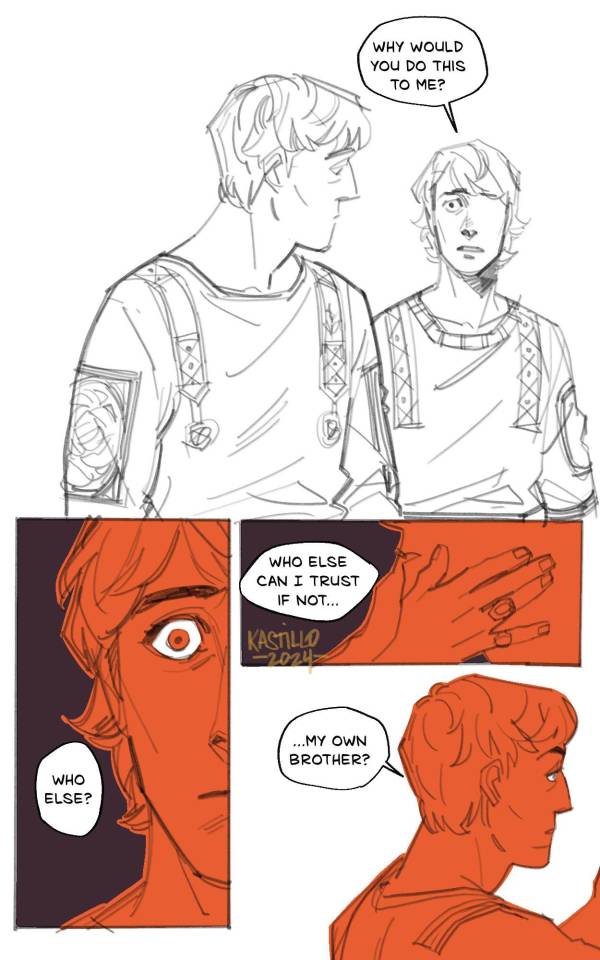
I got. thoughts. about valens and voices in imperial roman history. but I also got a lot of thoughts about uhhhhhh choosing your brother for co ruling the Fratricide Foundation Story Empire. many thoughts about themistius' oration too

Brotherly Love, Themistius (trans. Peter Heather & David Moncur)
⭐ places I’m at! bsky / pixiv / pillowfort /cohost / cara.app / insta
#it's also the Incest-Cannibalism Empire but that's a discussion for a different blog#all of the heavy hitters were Incest Empires btw. that's a feature of Empire across all of time. not always Cannibalism tho. TRAGIC.#but rome specifically being the Fratricide&Stuprum Empire is funny AND makes parts of this speech feel. uh. UHHHHH.#feels like you're trying to overwrite history and while you succeeded ONCE the uncle-nephew antagonism with a body count#somehow feels worse????? feels worse. i dont like anything that happened to valentinian 2#anyway. as a result: i personally will be including the bigamy accusations against valentinian into my belief system#stuprum babyyyyy! a requirement for every emperor! valens is lacking here so valentinian has to pick up the slack#valens will be giving me an opening to fire shots at figures in christianity i dislike which is honestly better than scandalous sex#later roman empire tag#komiks tag#brother emperors tag#IF. you missed my brother emperors posting. the head in hands thing here is meant to be a little bit offputting on account of#valentinian being valens' imperial maker. that's a life in your hands. overtures of fratricide. etc. you get the point#whatever other subtext you want to apply to it from the subtext spice cabinet. im not picky. this was a quick comic i did#to shake off the depression cobwebs lmao. eventually i'll style guide this era and do comics with more intentional thought later
208 notes
·
View notes
Text

tolkien (a studied linguist) and me (has taken their fair share of linguistic classes) staring at each other after the narrator casually drops that the hobbits just 'forgot' their languages and simply adopted the common speech as if that is a normal thing that happens out of the blue and isn't connected to at best cultural assimilation and at worst colonialism, imperialism, and oppression

#personal#lotr newsletter#lotr lb#love that you always find new stuff to think about with these books#like this is very easy to read over and simply accept bc it's such a small paragraph and also it's not presented as something super bad?#like i'm not saying the dunedain violently oppressed the hobbits and forced them to learn a new language or smth#but girl the implications...#like there certainly had to have been some kind of hierarchy so that the common speech had more prestige than whatever the hobbits spoke#bc they were multiple languages they were speaking!#like idk what it means rn but it's a fascinating choice to me that they forgot their languages except for a few words.#lmao maybe i'm also thinking too radically about this maybe it's not that deep. but it certainly caught me off guard reading hahaha#*closes the tabs on language death i had opened*
165 notes
·
View notes
Text



aryna sabalenka at the italian open (18.05.2024)
180 notes
·
View notes
Text
Not that I've ever thought the live-action Netflix Avatar show was going to be good, but...
I do think people are blowing a lot of this out of proportion. Again, this is an adaptation, not a 1:1 translation. There's going to be a lot of differences. There's a whole lot of "Oh, they RUINED IT!" going around, and the show's not dropping for another three weeks.
It's all just a question of how effectively they're going to streamline it, and whether the character arcs and actions are going to make sense.
#at the same time I once again REALLY wanna see how Jurassic Park Book Fans reacted to Grant's opening speech in the movie#''You think his vision's based on movement like T Rex'' ''HOW WOULD HE KNOW THAT???''#now are they probably going to miss some big character traits?#probably#but it could be all right#ALSO REMEMBER: BE NICE TO THE KIDS#atla#avatar the last airbender#the last netflix
195 notes
·
View notes
Text

[Image description start. The three panel, "Do you think Margaret Thatcher had girl power" meme, now edited so that the first panel shows the TV host asking:
"Do you think you are protecting democracy by voting blue no matter who?"
The second panel shows someone responding, "Yes, of course."
Panel 3 has the TV host asking, "Do you think you are protecting democracy by announcing to all politicians who will ever exist from now on that they can commit as many genocides as they want and they'll still get elected because you literally don't care what they do as long as they don't do it to you?".
Image description end.]
I explicitly encourage everyone to download and repost this and use it as a reaction image. You can copy and paste the image descritption into your post. If you're on mobile, if your phone has a notepad app, you can save it there.
#made with speech to text#Described images#vote blue no matter who#Genocide apologism#Democracy#Genocide Joe#Butcher Biden#White supremacy#Described memes#Accessible memes#Antifa#Antifascism#Antifascist#Leopards eating people's faces party#You are not protecting democracy by screaming from the rooftops that you're fine with politicians committing genocide#You are in fact pushing this inherently undemocratic system even closer towards “ open ” fascism
94 notes
·
View notes
Text
Not to make everything political but…is Donald Trump the guy you want opening the 2028 Olympics and Paralympics?
Let’s not have a repeat of Berlin ‘36 please
#he’ll have to make a speech at each opening ceremony#imagine the gross ableism that would spew out of his disgusting mouth at the paralympics#us politics#american politics#politics#olympics#olympics 2028#paralympics#paralympics 2028#los angeles 2028#la 2028#donald trump#kamala harris
71 notes
·
View notes
Text
Hey everyone! this is where the zebra is currently with the design.
It has knee braces!! I will most probably be drawing the zebra usually with them on, but it’s no requirement, for example if anyone else wants to draw the zebra :-]. I always like to make sure an animal design has official colors underneath any clothing and accessory anyway. I think this will be final! thank you everyone for your feedback!
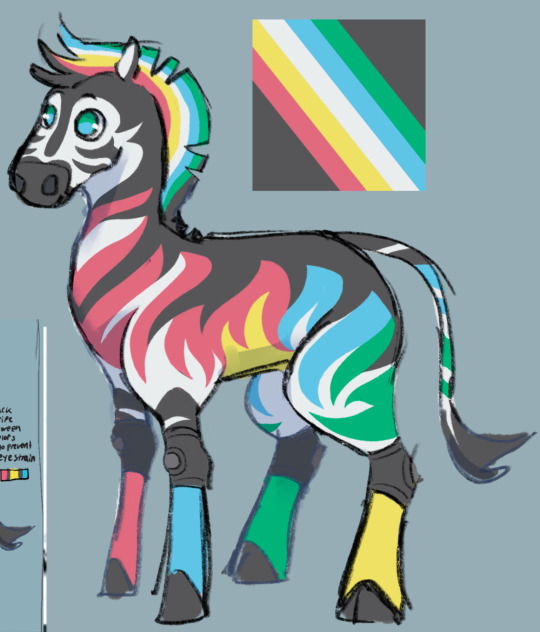

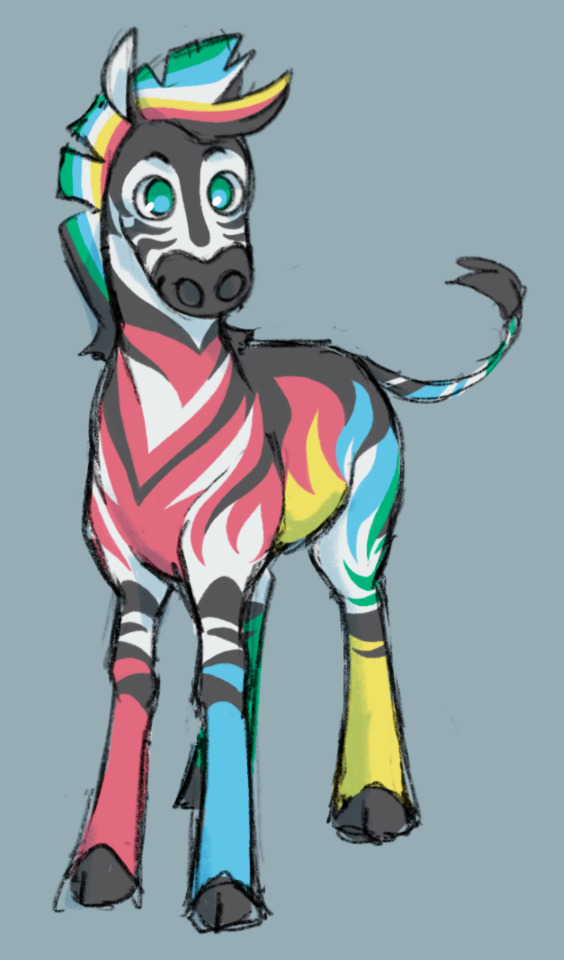
As a reminder, aside from why the zebra was requested for this flag, this is also just a zebra with the disability pride flag on it. It’s just a deisgn to fit the flag, with input from other disabled people in our community. It doesn’t mean other animals can’t have designs with these colors, too! I don’t mean this design to be the only mascot for all disabled people. It’s just a silly series i do of pride animals, and at the time, during disability pride month, I wanted to see what everyone wanted me to start off with for this flag!
the goal with my pride animals is to take requests and make people feel happy and seen.. that’s all <:-)
#disability pride#pride animals#disability#disability pride flag#zebras#I’ve been a little stressed about this animal for the past week.. I will be honest with you#The zebra has many stripes and I wanted to try my best to make sure it wouldn’t cause issues like headaches or other things#also.. if]ve been working on this for a while now.. i want to call it done soon!#But now that this is finished#I will start designing stickers and pins to put on redbubble and also for me to print IRL!#thank you everyone! I’ve also learned more than whatbI already knew this week#Even if it was stressful it was fun to see everyone get so excited when I would show updates to the designs#Sorry for a long speech.. I am a very nervous person today#Excuse my typos! I’m a fast typer and tired from the day#ebonytailsart#Thank you yomcloud for giving me your feedback as well. I don’t have a lot of perspective on visual processing disorders and photensitivity#so it meant a lot to me#just like the other pride animals I am very open to making more animal designs for this flag! But I’d like to save it for the future instea#It’s a bit too soon at the moment. thank youuu
161 notes
·
View notes
Text


Boy was glued to his phone while changing after the match
#this went on for like five mins until hubi joined him#he actually put it away several times to just get it back from his bag agin#probably getting the infos from anna and cheering her up to then announce her result during his thank you speech#he is down so bad#Jannik sinner#tennis#halle open#my gifs
108 notes
·
View notes
Text
If you want to stop KOSA, a censorship bill in a child safety trench coat, call or email your representatives this week because some senators are trying to add it to a must-pass package (same way TikTok ban was passed).
https://thehill.com/policy/technology/4639679-senators-try-to-add-kids-online-safety-bills-to-faa-act/
101 notes
·
View notes
Text


there's smthn about simon closing his eyes at 'i love you' at the end of season 1
and wille opening his eyes at 'i love you' at the end of season 2
#perhaps its linked to the pain between them both and how they're love has to be hidden#contrasted with wille's upcoming actions in his speech#maybe it was literally eye opening#i love them#young royals#simon young royals#wilhelm young royals#wilmon#yr s2#yr s1
199 notes
·
View notes
Text
"Open" "AI" isn’t

Tomorrow (19 Aug), I'm appearing at the San Diego Union-Tribune Festival of Books. I'm on a 2:30PM panel called "Return From Retirement," followed by a signing:
https://www.sandiegouniontribune.com/festivalofbooks

The crybabies who freak out about The Communist Manifesto appearing on university curriculum clearly never read it – chapter one is basically a long hymn to capitalism's flexibility and inventiveness, its ability to change form and adapt itself to everything the world throws at it and come out on top:
https://www.marxists.org/archive/marx/works/1848/communist-manifesto/ch01.htm#007
Today, leftists signal this protean capacity of capital with the -washing suffix: greenwashing, genderwashing, queerwashing, wokewashing – all the ways capital cloaks itself in liberatory, progressive values, while still serving as a force for extraction, exploitation, and political corruption.
A smart capitalist is someone who, sensing the outrage at a world run by 150 old white guys in boardrooms, proposes replacing half of them with women, queers, and people of color. This is a superficial maneuver, sure, but it's an incredibly effective one.
In "Open (For Business): Big Tech, Concentrated Power, and the Political Economy of Open AI," a new working paper, Meredith Whittaker, David Gray Widder and Sarah B Myers document a new kind of -washing: openwashing:
https://papers.ssrn.com/sol3/papers.cfm?abstract_id=4543807
Openwashing is the trick that large "AI" companies use to evade regulation and neutralizing critics, by casting themselves as forces of ethical capitalism, committed to the virtue of openness. No one should be surprised to learn that the products of the "open" wing of an industry whose products are neither "artificial," nor "intelligent," are also not "open." Every word AI huxters say is a lie; including "and," and "the."
So what work does the "open" in "open AI" do? "Open" here is supposed to invoke the "open" in "open source," a movement that emphasizes a software development methodology that promotes code transparency, reusability and extensibility, which are three important virtues.
But "open source" itself is an offshoot of a more foundational movement, the Free Software movement, whose goal is to promote freedom, and whose method is openness. The point of software freedom was technological self-determination, the right of technology users to decide not just what their technology does, but who it does it to and who it does it for:
https://locusmag.com/2022/01/cory-doctorow-science-fiction-is-a-luddite-literature/
The open source split from free software was ostensibly driven by the need to reassure investors and businesspeople so they would join the movement. The "free" in free software is (deliberately) ambiguous, a bit of wordplay that sometimes misleads people into thinking it means "Free as in Beer" when really it means "Free as in Speech" (in Romance languages, these distinctions are captured by translating "free" as "libre" rather than "gratis").
The idea behind open source was to rebrand free software in a less ambiguous – and more instrumental – package that stressed cost-savings and software quality, as well as "ecosystem benefits" from a co-operative form of development that recruited tinkerers, independents, and rivals to contribute to a robust infrastructural commons.
But "open" doesn't merely resolve the linguistic ambiguity of libre vs gratis – it does so by removing the "liberty" from "libre," the "freedom" from "free." "Open" changes the pole-star that movement participants follow as they set their course. Rather than asking "Which course of action makes us more free?" they ask, "Which course of action makes our software better?"
Thus, by dribs and drabs, the freedom leeches out of openness. Today's tech giants have mobilized "open" to create a two-tier system: the largest tech firms enjoy broad freedom themselves – they alone get to decide how their software stack is configured. But for all of us who rely on that (increasingly unavoidable) software stack, all we have is "open": the ability to peer inside that software and see how it works, and perhaps suggest improvements to it:
https://www.youtube.com/watch?v=vBknF2yUZZ8
In the Big Tech internet, it's freedom for them, openness for us. "Openness" – transparency, reusability and extensibility – is valuable, but it shouldn't be mistaken for technological self-determination. As the tech sector becomes ever-more concentrated, the limits of openness become more apparent.
But even by those standards, the openness of "open AI" is thin gruel indeed (that goes triple for the company that calls itself "OpenAI," which is a particularly egregious openwasher).
The paper's authors start by suggesting that the "open" in "open AI" is meant to imply that an "open AI" can be scratch-built by competitors (or even hobbyists), but that this isn't true. Not only is the material that "open AI" companies publish insufficient for reproducing their products, even if those gaps were plugged, the resource burden required to do so is so intense that only the largest companies could do so.
Beyond this, the "open" parts of "open AI" are insufficient for achieving the other claimed benefits of "open AI": they don't promote auditing, or safety, or competition. Indeed, they often cut against these goals.
"Open AI" is a wordgame that exploits the malleability of "open," but also the ambiguity of the term "AI": "a grab bag of approaches, not… a technical term of art, but more … marketing and a signifier of aspirations." Hitching this vague term to "open" creates all kinds of bait-and-switch opportunities.
That's how you get Meta claiming that LLaMa2 is "open source," despite being licensed in a way that is absolutely incompatible with any widely accepted definition of the term:
https://blog.opensource.org/metas-llama-2-license-is-not-open-source/
LLaMa-2 is a particularly egregious openwashing example, but there are plenty of other ways that "open" is misleadingly applied to AI: sometimes it means you can see the source code, sometimes that you can see the training data, and sometimes that you can tune a model, all to different degrees, alone and in combination.
But even the most "open" systems can't be independently replicated, due to raw computing requirements. This isn't the fault of the AI industry – the computational intensity is a fact, not a choice – but when the AI industry claims that "open" will "democratize" AI, they are hiding the ball. People who hear these "democratization" claims (especially policymakers) are thinking about entrepreneurial kids in garages, but unless these kids have access to multi-billion-dollar data centers, they can't be "disruptors" who topple tech giants with cool new ideas. At best, they can hope to pay rent to those giants for access to their compute grids, in order to create products and services at the margin that rely on existing products, rather than displacing them.
The "open" story, with its claims of democratization, is an especially important one in the context of regulation. In Europe, where a variety of AI regulations have been proposed, the AI industry has co-opted the open source movement's hard-won narrative battles about the harms of ill-considered regulation.
For open source (and free software) advocates, many tech regulations aimed at taming large, abusive companies – such as requirements to surveil and control users to extinguish toxic behavior – wreak collateral damage on the free, open, user-centric systems that we see as superior alternatives to Big Tech. This leads to the paradoxical effect of passing regulation to "punish" Big Tech that end up simply shaving an infinitesimal percentage off the giants' profits, while destroying the small co-ops, nonprofits and startups before they can grow to be a viable alternative.
The years-long fight to get regulators to understand this risk has been waged by principled actors working for subsistence nonprofit wages or for free, and now the AI industry is capitalizing on lawmakers' hard-won consideration for collateral damage by claiming to be "open AI" and thus vulnerable to overbroad regulation.
But the "open" projects that lawmakers have been coached to value are precious because they deliver a level playing field, competition, innovation and democratization – all things that "open AI" fails to deliver. The regulations the AI industry is fighting also don't necessarily implicate the speech implications that are core to protecting free software:
https://www.eff.org/deeplinks/2015/04/remembering-case-established-code-speech
Just think about LLaMa-2. You can download it for free, along with the model weights it relies on – but not detailed specs for the data that was used in its training. And the source-code is licensed under a homebrewed license cooked up by Meta's lawyers, a license that only glancingly resembles anything from the Open Source Definition:
https://opensource.org/osd/
Core to Big Tech companies' "open AI" offerings are tools, like Meta's PyTorch and Google's TensorFlow. These tools are indeed "open source," licensed under real OSS terms. But they are designed and maintained by the companies that sponsor them, and optimize for the proprietary back-ends each company offers in its own cloud. When programmers train themselves to develop in these environments, they are gaining expertise in adding value to a monopolist's ecosystem, locking themselves in with their own expertise. This a classic example of software freedom for tech giants and open source for the rest of us.
One way to understand how "open" can produce a lock-in that "free" might prevent is to think of Android: Android is an open platform in the sense that its sourcecode is freely licensed, but the existence of Android doesn't make it any easier to challenge the mobile OS duopoly with a new mobile OS; nor does it make it easier to switch from Android to iOS and vice versa.
Another example: MongoDB, a free/open database tool that was adopted by Amazon, which subsequently forked the codebase and tuning it to work on their proprietary cloud infrastructure.
The value of open tooling as a stickytrap for creating a pool of developers who end up as sharecroppers who are glued to a specific company's closed infrastructure is well-understood and openly acknowledged by "open AI" companies. Zuckerberg boasts about how PyTorch ropes developers into Meta's stack, "when there are opportunities to make integrations with products, [so] it’s much easier to make sure that developers and other folks are compatible with the things that we need in the way that our systems work."
Tooling is a relatively obscure issue, primarily debated by developers. A much broader debate has raged over training data – how it is acquired, labeled, sorted and used. Many of the biggest "open AI" companies are totally opaque when it comes to training data. Google and OpenAI won't even say how many pieces of data went into their models' training – let alone which data they used.
Other "open AI" companies use publicly available datasets like the Pile and CommonCrawl. But you can't replicate their models by shoveling these datasets into an algorithm. Each one has to be groomed – labeled, sorted, de-duplicated, and otherwise filtered. Many "open" models merge these datasets with other, proprietary sets, in varying (and secret) proportions.
Quality filtering and labeling for training data is incredibly expensive and labor-intensive, and involves some of the most exploitative and traumatizing clickwork in the world, as poorly paid workers in the Global South make pennies for reviewing data that includes graphic violence, rape, and gore.
Not only is the product of this "data pipeline" kept a secret by "open" companies, the very nature of the pipeline is likewise cloaked in mystery, in order to obscure the exploitative labor relations it embodies (the joke that "AI" stands for "absent Indians" comes out of the South Asian clickwork industry).
The most common "open" in "open AI" is a model that arrives built and trained, which is "open" in the sense that end-users can "fine-tune" it – usually while running it on the manufacturer's own proprietary cloud hardware, under that company's supervision and surveillance. These tunable models are undocumented blobs, not the rigorously peer-reviewed transparent tools celebrated by the open source movement.
If "open" was a way to transform "free software" from an ethical proposition to an efficient methodology for developing high-quality software; then "open AI" is a way to transform "open source" into a rent-extracting black box.
Some "open AI" has slipped out of the corporate silo. Meta's LLaMa was leaked by early testers, republished on 4chan, and is now in the wild. Some exciting stuff has emerged from this, but despite this work happening outside of Meta's control, it is not without benefits to Meta. As an infamous leaked Google memo explains:
Paradoxically, the one clear winner in all of this is Meta. Because the leaked model was theirs, they have effectively garnered an entire planet's worth of free labor. Since most open source innovation is happening on top of their architecture, there is nothing stopping them from directly incorporating it into their products.
https://www.searchenginejournal.com/leaked-google-memo-admits-defeat-by-open-source-ai/486290/
Thus, "open AI" is best understood as "as free product development" for large, well-capitalized AI companies, conducted by tinkerers who will not be able to escape these giants' proprietary compute silos and opaque training corpuses, and whose work product is guaranteed to be compatible with the giants' own systems.
The instrumental story about the virtues of "open" often invoke auditability: the fact that anyone can look at the source code makes it easier for bugs to be identified. But as open source projects have learned the hard way, the fact that anyone can audit your widely used, high-stakes code doesn't mean that anyone will.
The Heartbleed vulnerability in OpenSSL was a wake-up call for the open source movement – a bug that endangered every secure webserver connection in the world, which had hidden in plain sight for years. The result was an admirable and successful effort to build institutions whose job it is to actually make use of open source transparency to conduct regular, deep, systemic audits.
In other words, "open" is a necessary, but insufficient, precondition for auditing. But when the "open AI" movement touts its "safety" thanks to its "auditability," it fails to describe any steps it is taking to replicate these auditing institutions – how they'll be constituted, funded and directed. The story starts and ends with "transparency" and then makes the unjustifiable leap to "safety," without any intermediate steps about how the one will turn into the other.
It's a Magic Underpants Gnome story, in other words:
Step One: Transparency
Step Two: ??
Step Three: Safety
https://www.youtube.com/watch?v=a5ih_TQWqCA
Meanwhile, OpenAI itself has gone on record as objecting to "burdensome mechanisms like licenses or audits" as an impediment to "innovation" – all the while arguing that these "burdensome mechanisms" should be mandatory for rival offerings that are more advanced than its own. To call this a "transparent ruse" is to do violence to good, hardworking transparent ruses all the world over:
https://openai.com/blog/governance-of-superintelligence
Some "open AI" is much more open than the industry dominating offerings. There's EleutherAI, a donor-supported nonprofit whose model comes with documentation and code, licensed Apache 2.0. There are also some smaller academic offerings: Vicuna (UCSD/CMU/Berkeley); Koala (Berkeley) and Alpaca (Stanford).
These are indeed more open (though Alpaca – which ran on a laptop – had to be withdrawn because it "hallucinated" so profusely). But to the extent that the "open AI" movement invokes (or cares about) these projects, it is in order to brandish them before hostile policymakers and say, "Won't someone please think of the academics?" These are the poster children for proposals like exempting AI from antitrust enforcement, but they're not significant players in the "open AI" industry, nor are they likely to be for so long as the largest companies are running the show:
https://papers.ssrn.com/sol3/papers.cfm?abstract_id=4493900

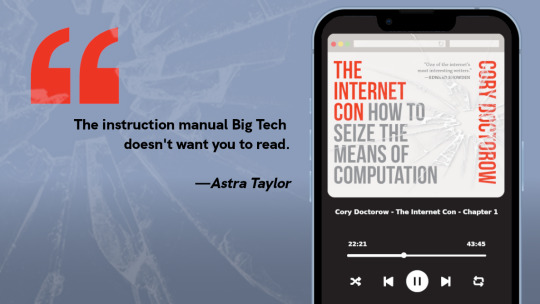
I'm kickstarting the audiobook for "The Internet Con: How To Seize the Means of Computation," a Big Tech disassembly manual to disenshittify the web and make a new, good internet to succeed the old, good internet. It's a DRM-free book, which means Audible won't carry it, so this crowdfunder is essential. Back now to get the audio, Verso hardcover and ebook:
http://seizethemeansofcomputation.org

If you'd like an essay-formatted version of this post to read or share, here's a link to it on pluralistic.net, my surveillance-free, ad-free, tracker-free blog:
https://pluralistic.net/2023/08/18/openwashing/#you-keep-using-that-word-i-do-not-think-it-means-what-you-think-it-means

Image:
Cryteria (modified)
https://commons.wikimedia.org/wiki/File:HAL9000.svg
CC BY 3.0
https://creativecommons.org/licenses/by/3.0/deed.en
#pluralistic#llama-2#meta#openwashing#floss#free software#open ai#open source#osi#open source initiative#osd#open source definition#code is speech
250 notes
·
View notes
Text


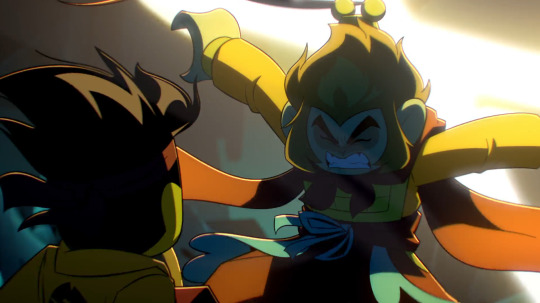


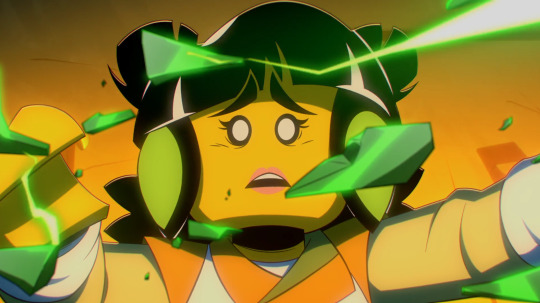
Protecting MK with a costlmk
#I will take my SWK and Mei parallel crumbs thank you#Like. Getting attacked by the curse and throwing yourself in front of MK (to which there are consequences) and then getting separated#Using your power to protect the people you care about indeed#So they both do it for MK but MK does it for Wukong in 4x13#And then what's the consequence? Going into Monkey Form#AND THEN. And then#If EAMK proves true and MK had a fucked up past life#We can then apply Azure's speech to MK: ''After all MK has put you through...''#Let me have this.#My ''MK killed the pilgrims'' agenda continues#Damn originally I was going to go on a ''protecting MK at a cost'' rant for why the exchange theme will ruin our lives#But I really got side tracked there#Anyways: MK's one life against the world#lmk#lego monkie kid#lmk parallels#lmk SWK#lmk Mei#lmk theme: exchange#opening my third eye tonight#to protect the ones I care about
201 notes
·
View notes
Text




No way
#wren draws stuff#saint seiya#pisces aphrodite#cancer deathmask#capricorn shura#shitpost#a friend sent me the first image with the only caption “IYKYK”#for some reasons I thought of the three idiots from Saint Seiya#the images I used of the Trash Trio are like... the only doodles of them I had in my gallery#they were practice sketches I made to try to understand the hair (I failed)#yeah there's a turnaround of Deathmask with a joint in my gallery and I hate it#it's also the album image preview so everytime I open that app he's there looking at me with that fucking smirk#Aphrodite and Shura are kind of okay but I lost my patience while drawing DM so if he's looking like a lil' shitty goblin that's the reason#Hm yeah I forgot DM has a lil speech bubble with “”“”“”I love weed“”“”“” whatever
105 notes
·
View notes
Text
So Luke was what Percy failed to save in the end, right? He was what mattered most? I’m gonna kill myself
#queued#because when they’re walking in the woods he brings up that line and Luke asks if he’s thinking about his mom#but Percy never confirms that. and it actually would make sense if Percy wasn’t worried hades would never return her because Poseidon told#him that he didn’t know WHEN hades would return her.#Percy’s whole speech to Luke was about how he had Figured Him Out and opening with the “fail to save what matters most” line makes it seem#like he was piecing together that that part of the prophecy applied to Luke too.#THIS IS THE BEST CHANGE THEY COULD HAVE POSSIBLY MADE TO THE SERIES IM SCREAMING#percy jackson and the olympians#pjo#percy jackson#pjo spoilers#pjo season 1#pjo ep 8#pjo 1x08#the prophecy comes true#pjo adaptation#pjo disney+#pjo tv series#pjo tv show#luke castellan#the lightning thief#charlie bushnell
107 notes
·
View notes